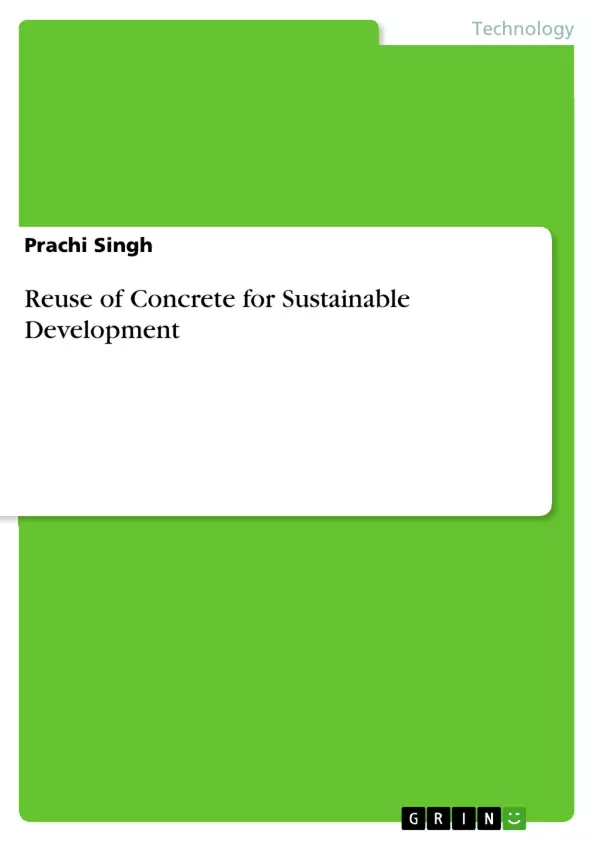Concrete is the most widely used construction material for infrastructure needs in the Asian region and in the world. Unfortunately, the concrete industry is one of the largest consumers of natural resources and energy, and is responsible for large emissions of carbon dioxide that is one of the greenhouse gases responsible for global warming. It is imperative that the concrete industry must be in an active role of balancing the infrastructure needs and the protection of environment.
This work presents a summary of some recent research closely associated with the sustainable development of concrete technology. The research projects include study and analysis of: - Causes of deterioration of concrete structures, problems at construction sites that causes early deterioration of concrete structures. In addition to above this book also presents some environmentally-friendly and sustainable concrete technology including the use of supplementary cementing materials (SCM), recycling concrete and other materials, enhancement of service life of concrete structures. Emerging technologies that have the potential to significantly contribute to sustainable concrete industry and barriers against reuse are presented at the end of book.
Inhaltsverzeichnis (Table of Contents)
- ABSTRACT
- I. INTRODUCTION
- II. DETERIORATION OF CONCRETE STRUCTURES
- III. CONSTRUCTION SITES- EARLY DETERIORATION
- IV. ENHANCEMENT OF CONCRETE REUSE
- V. EMERGING TECHNOLOGIES
- VI. BARRIERS AGAINST REUSE
- VII. CONCLUSION
Zielsetzung und Themenschwerpunkte (Objectives and Key Themes)
This work aims to explore the potential of concrete reuse as a sustainable development strategy within the concrete industry. It focuses on the challenges faced by the industry to meet both current and future needs while considering environmental, social, and economic factors. The text investigates causes of concrete deterioration and explores environmentally friendly and sustainable technologies for concrete reuse.
- Concrete deterioration and its causes
- Sustainable development and its implications for the concrete industry
- Concrete reuse and recycling technologies
- Barriers and challenges to concrete reuse
- Emerging technologies for sustainable concrete production
Zusammenfassung der Kapitel (Chapter Summaries)
- I. INTRODUCTION: This chapter sets the stage for the discussion by highlighting the significance of concrete as a construction material and the challenges associated with its environmental impact. It emphasizes the need for sustainable development in the concrete industry and outlines the key elements of sustainability, including environmental stewardship, social responsibility, and economic prosperity. The chapter also introduces the concept of concrete recycling and its potential benefits, outlining three categories of by-product use related to concrete.
- II. DETERIORATION OF CONCRETE STRUCTURES: This chapter delves into the causes of deterioration in concrete structures, providing examples and photographic evidence of common issues like carbonation, chloride-induced corrosion, drying shrinkage, and poor construction practices. It discusses factors contributing to rapid deterioration, such as high humidity, inadequate concrete strength, and poor workmanship. This chapter provides a detailed look at the mechanisms of concrete deterioration and its impact on the durability of structures.
- III. CONSTRUCTION SITES- EARLY DETERIORATION: This chapter explores the causes of early deterioration in concrete structures that occur at construction sites. It highlights factors like un-sieved and unwashed aggregates, inappropriate mixing techniques, poor compaction, and lack of proper curing as major contributors to early deterioration. The chapter also stresses the importance of skilled labor, proper training, and quality control at construction sites.
- IV. ENHANCEMENT OF CONCRETE REUSE: This chapter focuses on the use of Supplementary Cementing Materials (SCMs) as a key strategy for enhancing concrete reuse. It introduces SCMs like fly ash and ground-granulated blast-furnace (GGBF) slag and explains their environmental benefits, such as reducing the need for Portland cement, decreasing greenhouse gas emissions, and improving the durability of concrete. The chapter discusses the potential for high-performance, high-volume fly ash concrete and the advantages of using GGBF slag as a cement substitute. This chapter provides insights into the practical applications of SCMs for sustainable concrete production.
Schlüsselwörter (Keywords)
The main keywords and focus topics of this work include concrete reuse, sustainable development, concrete durability, supplementary cementing materials (SCMs), and environmental impact. The text explores the importance of these concepts in the context of achieving sustainable and harmonious development within the concrete industry.
- Quote paper
- Prachi Singh (Author), 2015, Reuse of Concrete for Sustainable Development, Munich, GRIN Verlag, https://www.grin.com/document/442654



